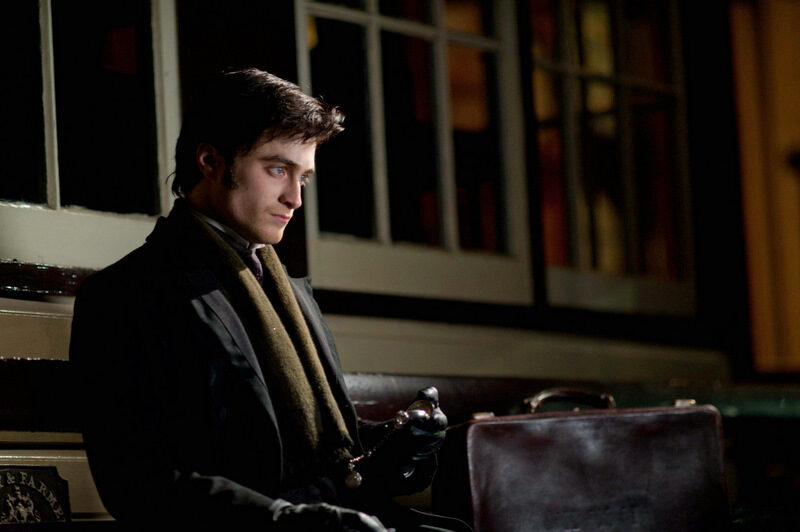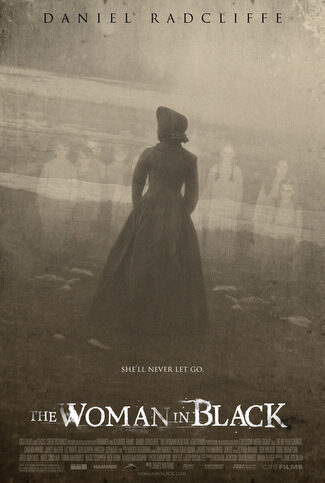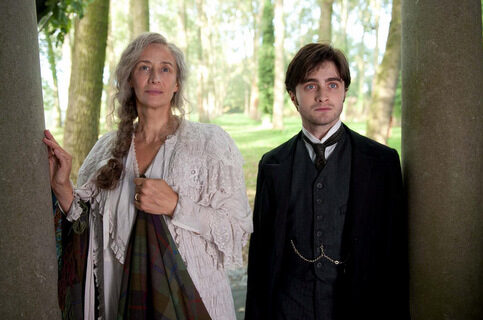Review: The Woman in Black |
 © 2012, Momentum Pictures 10 Feb ’12
© 2012, Momentum Pictures 10 Feb ’12
Starring: Daniel Radcliffe, Ciarán Hinds, Janet McTeer
Directed By: James Watkins
Victorian was a transitional age between classical romance and practical industry. It eventually gave way to economic upheaval in the Edwardian era, when Gothic mystery became less important than socialism. Clothing too was on the cusp of change. Frock coats and heavy lace dresses would soon be lost to ceremony, imbuing them with a theatricality that performs especially well in the horror genre.
From recently resurrected production company Hammer, The Woman in Black is more accurately a ghost story; though do not think for a second that will dampen your fear. It won’t. Estate lawyer Arthur Kipps (Daniel Radcliffe) is our guide into this cruel world. Bloodless pale skin, dark stubble (clearly an attempt to add years on the young actor), permanently attired in frock coat, waistcoat with matching high-waist trousers and top frock – a double breasted, calf length coat with fabric buttons worn as outerwear; because Kipps only has the one change throughout the film he takes on a persistent spectral presence, much like the Woman in Black herself.
 Director James Watkins and costume designer Keith Madden undertook extensive research to find the perfect attire for their ghost. The clue is in the film’s title; it had to be mourning dress.
Director James Watkins and costume designer Keith Madden undertook extensive research to find the perfect attire for their ghost. The clue is in the film’s title; it had to be mourning dress.Watkins and costume designer Keith Madden ensure Kipps’ appearance jars with the remote coastal village he visits. As such he is immediately treated with suspicion by those who live there. Ironically the first of the village patrons to acknowledge Kipps’ differentiation, Mr. Daily (Ciarán Hinds), would likely be clad this way himself if he lived in the city. Although from different generations, both men share a similar social footing, even if Kipps is several steps behind Daily at present.
Tellingly for the locale, Daily is introduced wearing a tweed lounge suit. “So, you’re from London” he notes of Kipps as they sit opposite each other in a train carriage. Daily knew Kipps was from London simply by his clothes. Later when he is invited to Daily’s home for supper, his host chooses a tuxedo as formal attire and not white tie with tails. Based on when the tuxedo was invented (a contentious issue in itself) and when it became popular, this puts the timeframe of the story around the early 1910s. Judging by Kipps’ ensemble alone it is unlikely to be any later. As with most male characters in the film Kipps does not wear a hat. Directors are notoriously fickle about headwear on their primary cast as it can make them difficult to light, which may have been the situation here.
 Janet McTeer as Mrs. Daily and Daniel Radcliffe as Arthur Kipps. Kipps only changes clothes once during the story and this is only because his original outfit becomes soiled (it is not made clear where he locates a freshly laundered version at precisely that moment). His appearance is resolute and stable, just like the Woman in Black.
Janet McTeer as Mrs. Daily and Daniel Radcliffe as Arthur Kipps. Kipps only changes clothes once during the story and this is only because his original outfit becomes soiled (it is not made clear where he locates a freshly laundered version at precisely that moment). His appearance is resolute and stable, just like the Woman in Black.Even without prior knowledge of Susan Hill’s novel, the TV movie or stageplay it should come as no surprise that the Woman in Black herself is covered head to foot in Victorian mourning dress. Mummified by constrictive lace with a high neckline and face hidden beneath a veil, Watkins instead relies on our imagination to create scares out of little more than shifting shadows or a door opening by itself. It is this simplicity that makes Daniel Radcliffe such a compelling watch. His sincere expressions and shifting blue eyes say far more than pages of languid exposition. We can grasp just how much pain emotional pain Kipps is in, he does not need to tell us.
The Woman in Black recreates a world as cold and dead as the vengeful ghost herself. There is a reason Hammer set so many of their horror stories during the Victorian and Edwardian era, and it was not just so they could re-use the costumes. Due largely to the very real fear of World War One, this is the last moment in history when anyone could be scared of the imaginary.
The Woman in Black (released 10th February) was viewed at Volkswagen’s See Film Differently screening in York featuring a live Q&A with director James Watkins. Visit their Facebook page to find out more about these wonderful ‘on location’ events.
© 2012, Chris Laverty.
